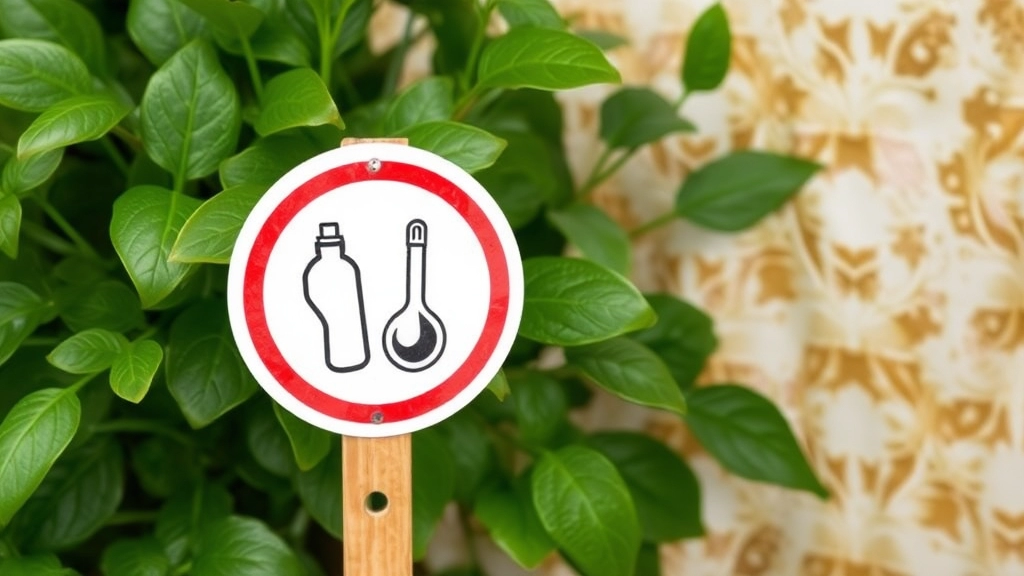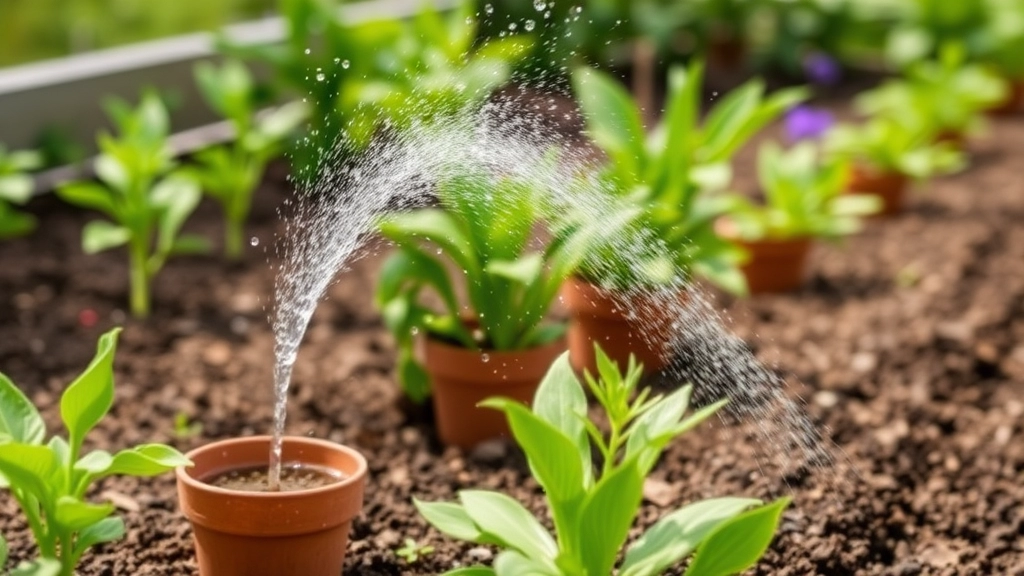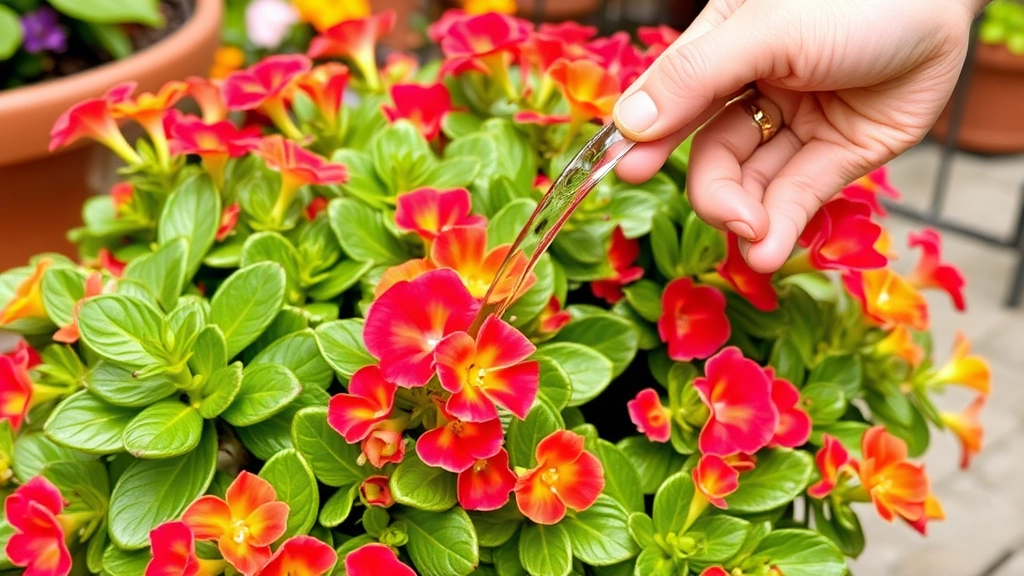Watering Your Kalanchoe
When it comes to florist Kalanchoe watering, getting it right is crucial for healthy growth. These succulents thrive with a specific watering routine. Typically, you should water your Kalanchoe once the top inch of soil feels dry. Overwatering is a common mistake, so always ensure the soil has proper drainage to prevent root rot.
How to Check if Your Kalanchoe Needs Water
To check if your Kalanchoe needs water, simply stick your finger into the soil. If it feels dry, it’s time to water. Be mindful of seasonal changes; during winter, Kalanchoe plants require less water compared to the growing season. By adapting your watering habits and paying attention to the soil, you can keep your Kalanchoe vibrant and healthy.
Watering Frequency for Florist Kalanchoe
When it comes to caring for your florist Kalanchoe, one of the most common concerns is how often to water it. Overwatering or underwatering can lead to serious issues, so it’s essential to find that sweet spot.
General Watering Guidelines
For Kalanchoe, a good rule of thumb is to water every two to three weeks. However, this can vary based on several factors:
- Season: During the growing season (spring and summer), your Kalanchoe may need more frequent watering.
- Humidity: In a humid environment, you might find that your plant requires less water.
- Pot Size: Smaller pots tend to dry out faster than larger ones.
Checking Soil Moisture
Before watering, always check the soil moisture. Stick your finger about an inch into the soil. If it feels dry, it’s time to water. If it’s still damp, hold off for a few more days.
Adjusting for Indoor and Outdoor Conditions
If your Kalanchoe is indoors, you may need to adjust your watering schedule based on the temperature and humidity of your home. Outdoor Kalanchoe may require more frequent watering, especially during hot, dry spells.
Best Soil Conditions for Proper Drainage

So, you’ve got your gorgeous Kalanchoe, and you’re wondering what kind of soil it needs to thrive.
The right soil is crucial for keeping your plant healthy and happy.
Here’s what you should look for:
- Well-Draining Mix: A mix specifically designed for succulents or cacti is ideal. These blends typically contain sand, perlite, or pumice to promote drainage.
- pH Level: Kalanchoes prefer slightly acidic to neutral soil, around 6.0 to 7.0. You can easily find pH-balanced potting mixes at your local garden centre.
- Avoid Heavy Soils: Steer clear of heavy garden soil or regular potting mix, as they retain too much moisture, leading to root rot.
- Additives for Aeration: If you’re feeling adventurous, you can mix in some coarse sand or small stones to enhance drainage.
- Container Choice: Don’t forget about the pot! Choose one with drainage holes. This ensures excess water can escape easily.
By setting your Kalanchoe up with the right soil conditions, you’re already on your way to growing a thriving plant.
Knowing when to water your Kalanchoe can be a source of concern for many plant enthusiasts. Overwatering or underwatering can lead to serious health issues for your plant. So, how do you figure out when your Kalanchoe is thirsty?
### 1. The Finger Test
One of the simplest methods is the finger test.
– Insert your finger about an inch into the soil.
– If it feels dry, it’s time to water.
– If it’s still moist, hold off for a few days.
### 2. Soil Moisture Meter
For those who prefer a more precise approach, consider using a soil moisture meter.
– This tool provides an accurate reading of the moisture levels in the soil.
– Aim for a reading between 2 and 4 for optimal watering.
### 3. Weight of the Pot
Another effective method is to gauge the weight of the pot.
– When the soil is dry, the pot will feel significantly lighter.
– Conversely, a heavier pot indicates moisture retention.
### 4. Leaf Texture and Colour
Keep an eye on your Kalanchoe’s leaves.
– Healthy leaves will be firm and plump.
– If they appear shrivelled or wrinkled, your plant may need water.
– On the flip side, yellowing leaves can indicate overwatering.
### 5. Time of Year
Understanding the seasonal needs of your Kalanchoe is crucial.
– In warmer months, your plant may require more frequent watering.
– During winter, it will need less due to reduced growth.
For more detailed guidance on how to care for your Kalanchoe, check out our [expert tips on Kalanchoe care](https://planthq.org/how-to-care-for-a-kalanchoe-succulent-expert-tips/). Additionally, if you are interested in learning about different Kalanchoe varieties, explore our [guide to Kalanchoe species](https://planthq.org/explore-different-kalanchoe-species-for-your-garden/).
Common Signs of Overwatering and Underwatering

Understanding the signs of overwatering and underwatering is crucial for maintaining a healthy Kalanchoe.
Overwatering Symptoms:
- Yellowing Leaves: One of the first indicators is the leaves turning yellow. This often starts at the lower leaves and can spread upwards.
- Wilting: Ironically, overwatered plants can also exhibit wilting, as the roots struggle to absorb nutrients.
- Mushy Stems: If the stems feel soft or mushy, it’s a clear sign that the roots are suffering from excess moisture.
- Root Rot: In severe cases, you may notice a foul smell coming from the soil, indicating root rot.
Underwatering Symptoms:
- Crispy Edges: If the leaf edges are turning brown and crispy, your Kalanchoe is likely thirsty.
- Shrivelling Leaves: Leaves may appear shrivelled or wrinkled, indicating the plant is in desperate need of water.
- Dropping Leaves: A Kalanchoe that is underwatered may start dropping its leaves in an effort to conserve moisture.
- Slow Growth: If your plant seems stagnant and isn’t growing as expected, it could be a sign of insufficient watering.
Tips to Avoid Root Rot in Kalanchoe
As we explore the crucial aspects of Kalanchoe care, understanding how to prevent root rot is essential for maintaining a healthy plant. Root rot can be a devastating issue, often caused by overwatering or poor drainage. Here are some practical tips to keep your Kalanchoe thriving:
Adapting Watering Schedule Based on Season

Have you ever wondered how the changing seasons affect your Kalanchoe’s watering needs?
It’s a game changer, really.
Spring and Summer:
- These are the growing seasons for your Kalanchoe.
- Water more frequently, about once a week.
- The warmer weather means your plant is using up more moisture.
Fall:
- As temperatures drop, your Kalanchoe starts to slow down.
- Cut back on watering to every 10-14 days.
- The plant doesn’t need as much water since it’s not actively growing.
Winter:
- This is the dormancy period.
- Water only when the top inch of soil feels dry, typically every 2-3 weeks.
- Overwatering can lead to root rot, so be cautious!
Adjusting your watering routine with the seasons can keep your Kalanchoe thriving.
When caring for your Kalanchoe, the environment in which it resides plays a crucial role in its watering needs.
### Indoor Kalanchoe Care:
Indoor Kalanchoe often benefits from controlled conditions. Here are some key considerations:
– **Humidity Levels:** Indoor air can be drier, especially in winter. This can lead to quicker evaporation of moisture from the soil.
– **Light Exposure:** Ensure your plant receives bright, indirect sunlight. Too much direct sunlight can scorch the leaves.
– **Temperature Fluctuations:** Indoor temperatures are usually stable, but avoid placing your Kalanchoe near heating vents or drafts.
### Outdoor Kalanchoe Care:
Outdoor Kalanchoe faces different challenges. Here’s what to keep in mind:
– **Natural Rainfall:** Be mindful of seasonal rainfall, which can affect your watering schedule. Adjust accordingly to prevent overwatering.
– **Soil Drainage:** Outdoor soil may retain more moisture. Ensure your Kalanchoe is planted in well-draining soil to prevent root rot.
– **Sunlight Exposure:** Outdoor plants may require more direct sunlight, so monitor their exposure to prevent leaf burn.
In both cases, understanding the specific needs of your Kalanchoe based on its location will help you maintain its health. For more tips on outdoor care, you can refer to our [outdoor Kalanchoe growing tips](https://planthq.org/outdoor-kalanchoe-growing-tips-expert-guide-for-florists/). Additionally, if you are interested in exploring different varieties, check out our guide on [top Kalanchoe succulent varieties and care tips](https://planthq.org/top-kalanchoe-succulent-varieties-and-care-tips/).
How to Revive an Overwatered Kalanchoe
So, you’ve noticed your Kalanchoe looking a bit worse for wear, and you suspect it might be overwatered. Don’t panic! There are steps you can take to nurse your plant back to health.
Assess the Damage
First things first, check the roots.
- Gently remove the plant from its pot.
- Look for brown, mushy roots. These are signs of rot.
If the roots look healthy, you’re in luck! If they’re not, you’ll want to trim away the damaged sections with clean scissors.
Let It Dry Out
Next, it’s time to dry things out.
- Leave the plant out of the pot for a few hours to let the roots breathe.
- Place it in a warm, dry spot away from direct sunlight.
This helps evaporate excess moisture.
Repot with Care
Once you’ve given it some time to dry, it’s time to repot.
- Use fresh, well-draining soil.
- Make sure the new pot has drainage holes.
This will help prevent future overwatering.
Adjust Your Watering Routine
Now that your Kalanchoe is back in its pot, it’s crucial to tweak your watering habits.
- Water only when the top inch of soil is dry.
- Remember, Kalanchoes prefer to be on the drier side! For more detailed guidance, check out our Kalanchoe Blossfeldiana leaf care tips.
Monitor and Be Patient
Keep an eye on your plant over the next few weeks.
- Look for new growth as a sign of recovery.
- Be patient; it might take some time to bounce back. If you’re interested in further tips on maintaining healthy Kalanchoe plants, our care tips for Kalanchoe succulents with yellow flowers might be helpful.
FAQs on Florist Kalanchoe Watering
What kind of soil is best for Kalanchoe plants?
The ideal soil for Kalanchoe plants is a well-draining mix designed specifically for succulents or cacti. These blends usually contain sand, perlite, or pumice to promote drainage. Avoid heavy garden soil or regular potting mix as they retain too much moisture, which can lead to root rot.
How do I know if I am overwatering my Kalanchoe?
Common signs of overwatering include yellowing leaves, wilting, mushy stems, and a foul smell from the soil indicating root rot. These symptoms often start at the lower leaves and can spread upwards.
What are the signs that my Kalanchoe is underwatered?
Indicators of underwatering include crispy edges on leaves, shrivelling or wrinkled leaves, dropping leaves, and slow growth. These signs suggest that the plant is in desperate need of water.
How often should I water my Kalanchoe in spring and summer?
During the growing seasons of spring and summer, water your Kalanchoe about once a week. The warmer weather means the plant is using up more moisture.
What is the watering schedule for Kalanchoe in the fall?
In the fall, as temperatures drop and the plant starts to slow down, cut back on watering to every 10-14 days. The plant doesn’t need as much water since it’s not actively growing.
How should I water my Kalanchoe in winter?
Winter is the dormancy period for Kalanchoe. Water only when the top inch of soil feels dry, typically every 2-3 weeks. Be cautious of overwatering to avoid root rot.
What pH level is suitable for Kalanchoe soil?
Kalanchoes prefer slightly acidic to neutral soil, with a pH level around 6.0 to 7.0. You can easily find pH-balanced potting mixes at your local garden centre.
Can I add anything to the soil to improve aeration?
Yes, you can mix in some coarse sand or small stones to enhance drainage and improve soil aeration. This can help keep your Kalanchoe’s roots healthy.
Why is container choice important for Kalanchoe plants?
Choosing a pot with drainage holes is crucial for Kalanchoe plants. This ensures that excess water can escape easily, preventing root rot and other moisture-related issues.
References
-
Kalanchoe Plant Care – Gardening Know How
-
Growing Kalanchoe Plants – The Spruce
-
Kalanchoe: How to Grow and Care for Kalanchoe Plants – The Old Farmer’s Almanac
